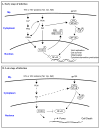New insights for FOXO and cell-fate decision in HIV infection and HIV associated neurocognitive disorder
- PMID: 20429422
- PMCID: PMC3407547
- DOI: 10.1007/978-1-4419-1599-3_11
New insights for FOXO and cell-fate decision in HIV infection and HIV associated neurocognitive disorder
Abstract
Human immunodeficiency virus Type 1 (HIV-1) infection and associated diseases continue to represent major health problem worldwide. FOXO transcriptional factors play an important role in the regulation of cell apoptosis, cell cycle arrest, stress resistance, metabolism and differentiation. This chapter will discuss the diverse functions of FOXO in different cell types including T-cells, macrophages, neurons and astrocytes within the context of HIV-1 infection. Given the overwhelming evidence that FOXO proteins influence the cell fate of immune cells and involve in the homeostasis of the central nervous system (CNS), we will also discuss the potential role of FOXO factors in HIV-1-associated neurological disorders.
Figures


Similar articles
-
Cocaine and HIV-1 Tat disrupt cholesterol homeostasis in astrocytes: Implications for HIV-associated neurocognitive disorders in cocaine user patients.Glia. 2018 Apr;66(4):889-902. doi: 10.1002/glia.23291. Epub 2018 Jan 13. Glia. 2018. PMID: 29330881 Free PMC article.
-
Evolving paradigms in the pathogenesis of HIV-1-associated dementia.Expert Rev Mol Med. 2005 Dec 2;7(27):1-26. doi: 10.1017/S1462399405010239. Expert Rev Mol Med. 2005. PMID: 16321172 Review.
-
HIV Neuropathogenesis in the Presence of a Disrupted Dopamine System.J Neuroimmune Pharmacol. 2020 Dec;15(4):729-742. doi: 10.1007/s11481-020-09927-6. Epub 2020 Jun 6. J Neuroimmune Pharmacol. 2020. PMID: 32506353 Free PMC article. Review.
-
Drug induced increases in CNS dopamine alter monocyte, macrophage and T cell functions: implications for HAND.J Neuroimmune Pharmacol. 2013 Jun;8(3):621-42. doi: 10.1007/s11481-013-9443-y. Epub 2013 Mar 1. J Neuroimmune Pharmacol. 2013. PMID: 23456305 Free PMC article. Review.
-
Does HIV infection contribute to increased beta-amyloid synthesis and plaque formation leading to neurodegeneration and Alzheimer's disease?J Neurovirol. 2019 Oct;25(5):634-647. doi: 10.1007/s13365-019-00732-3. Epub 2019 Mar 13. J Neurovirol. 2019. PMID: 30868421 Review.
Cited by
-
MicroRNA-183-96-182 Cluster Regulates Bovine Granulosa Cell Proliferation and Cell Cycle Transition by Coordinately Targeting FOXO1.Biol Reprod. 2016 Jun;94(6):127. doi: 10.1095/biolreprod.115.137539. Epub 2016 Apr 27. Biol Reprod. 2016. PMID: 27122636 Free PMC article.
-
STAT1 regulates human glutaminase 1 promoter activity through multiple binding sites in HIV-1 infected macrophages.PLoS One. 2013 Sep 24;8(9):e76581. doi: 10.1371/journal.pone.0076581. eCollection 2013. PLoS One. 2013. PMID: 24086752 Free PMC article.
-
Expression pattern analysis of the long non-coding RNAs (TINCR, RP11-573D15.8, RP11-156E8.1), and their target genes (AKT1, FOXO1 and MAPK3) in patients with HIV infection, and elite controllers.Heliyon. 2024 May 10;10(10):e30900. doi: 10.1016/j.heliyon.2024.e30900. eCollection 2024 May 30. Heliyon. 2024. PMID: 38803943 Free PMC article.
-
Involvement of the up-regulated FoxO1 expression in follicular granulosa cell apoptosis induced by oxidative stress.J Biol Chem. 2012 Jul 27;287(31):25727-40. doi: 10.1074/jbc.M112.349902. Epub 2012 Jun 4. J Biol Chem. 2012. PMID: 22669940 Free PMC article.
-
Suppression of Foxo1 activity and down-modulation of CD62L (L-selectin) in HIV-1 infected resting CD4 T cells.PLoS One. 2014 Oct 16;9(10):e110719. doi: 10.1371/journal.pone.0110719. eCollection 2014. PLoS One. 2014. PMID: 25330112 Free PMC article.
References
-
- Galili N, Davis RJ, Fredericks WJ, et al. Fusion of a fork head domain gene to PAX3 in the solid tumour alveolar rhabdomyosarcoma. Nat Genet. 1993 Nov;5(3):230–235. - PubMed
-
- Hillion J, Le Coniat M, Jonveaux P, Berger R, Bernard OA. AF6q21, a novel partner of the MLL gene in t(6;11)(q21;q23), defines a forkhead transcriptional factor subfamily. Blood. 1997 Nov 1;90(9):3714–3719. - PubMed
-
- Anderson MJ, Viars CS, Czekay S, Cavenee WK, Arden KC. Cloning and characterization of three human forkhead genes that comprise an FKHR-like gene subfamily. Genomics. 1998 Jan 15;47(2):187–199. - PubMed
-
- Borkhardt A, Repp R, Haas OA, et al. Cloning and characterization of AFX, the gene that fuses to MLL in acute leukemias with a t(X;11)(q13;q23) Oncogene. 1997 Jan 16;14(2):195–202. - PubMed
-
- Jacobs FM, van der Heide LP, Wijchers PJ, Burbach JP, Hoekman MF, Smidt MP. FoxO6, a novel member of the FoxO class of transcription factors with distinct shuttling dynamics. J Biol Chem. 2003 Sep 19;278(38):35959–35967. - PubMed
Publication types
MeSH terms
Substances
Grants and funding
LinkOut - more resources
Full Text Sources
Medical

